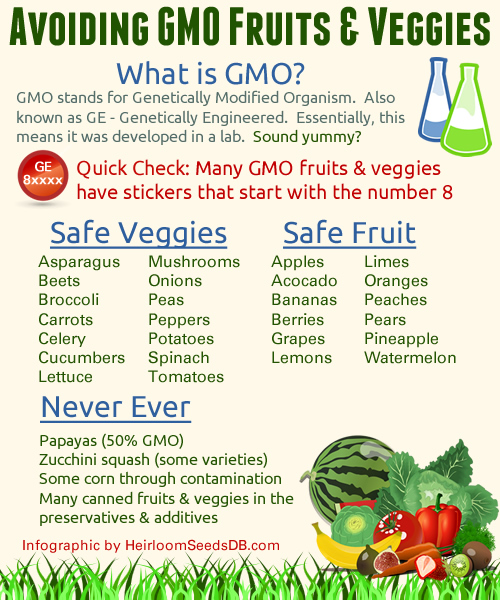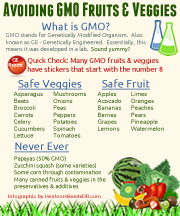A quick reference for what is safe and not safe when wanting to buy fresh fruits and veggies at the grocery store. And we will keep it up to date as more GMOs unfortunately enter the market area  Unfortunately GMO seeds are still becoming more popular with commercial growers (but that is a whole other issue I will be tackling soon). Please share!
Unfortunately GMO seeds are still becoming more popular with commercial growers (but that is a whole other issue I will be tackling soon). Please share!

To add this to your blog or website, cut and paste:
<a href=”http://www.heirloomseedsdb.com/gmo/avoiding-gmo-fruits-veggies/”><img src=”http://www.heirloomseedsdb.com/nongmfruitsandveggies.jpg” alt=”Avoiding GMO Fruits & Veggies” /> Brought to you by </a><a href=”http://www.heirloomseedsdb.com”>Heirloom Seeds Database</a>, your independent source for heirlooms.</a>
Or use our social buttons below to add to Twitter, Facebook or Pinterest!
Share and Enjoy
































I’m confused as to why Tomoatoes, grapes, cucumber, watermelon are on the safe list? Aren’t most GE’d to be seedless etc?
You are confusing hybrids with genetically engineered, which happens a lot because the GMO industry wants to confuse people so they aren’t concerned about the issue. Hybrid merely means two different but closely related varieties are cross-pollinated to create a new hybrid (say crossing a favorite large tomato with another tomato that is a lot more prolific, hoping the end result is a more prolific version of the favorite tomato). This also happens naturally in gardens when you have lots of variety of veggies planted, they cross-pollinate naturally in the wind or with insects, and then you save the seeds for them at the end of the growing season.
Genetically engineered veggies/fruits are created in a lab by changing the plant’s DNA using genetic engineering. Think of it as a sort of in-vitro fertilization among plants that would never be able to occur naturually. In more understandable terms, it would be similar to trying to cross a dog and a cat genetically through DNA in a high tech lab, something that could definitely not happen in nature. This is also why you often hear GMO / GE food called frankenfood.
Hi, I just wanted to add that I have seen this flyer posted to facebook and it’s inaccurate/outdated, unfortunate that it has to be updated. I have read that most potato’s are now GMO, as are soybeans.. Corn is also mostly GMO, unless organic, as are strawberries, so the berries are not always a safe bet.. I may have missed a few, but I think this really has to be updated for the safety and health of our citizens. We still have no idea how dangerous GM foods are, so we must be careful of our facts. Hopefully one day soon, we will see a list where GMO foods are no longer listed, because they no longer exist!! Namaste ~
[…] Avoiding GMO Fruits & Veggies (Infographic) […]
[…] Avoiding GMO Fruits & Veggies (Infographic) […]